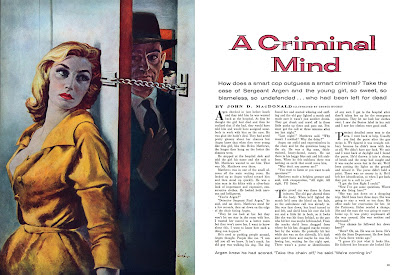
Back in the 1970s when I first started collecting John D MacDonald fiction, I had to admit that I was more than a little surprised to learn he had published so many stories and novels in Cosmopolitan magazine. The Cosmo I knew growing up was a woman's magazine, and one my mother would not permit in the house. Edited by Helen Gurley Brown, the author of the wildly popular novel Sex and the Single Girl, the magazine was marketed to single women who weren't ashamed to admit they enjoyed sex outside of marriage. This was the sort of behavior MacDonald frowned on in his writing. This type of women was either a tramp or a nymphomaniac, or both, possessing little self-worth, and they were often the villains of his stories. He once famously wrote (speaking through Travis McGee) "A woman who does not guard and treasure herself cannot be of very much value to anyone else." What would MacDonald be doing in the pages of such a magazine?
When I finally did some investigating I learned that Cosmopolitan wasn't always a magazine for single girls, or even one exclusively for women. It had a long, rich history as a place where a reader could find top-notch fiction, going back as far as 1886! It had serialized H.G. Wells' War of the Worlds and had featured the works of such literary giants as Theodore Dreiser, Edith Wharton, A J Cronin, George Bernard Shaw and Sinclair Lewis. It had been owned by William Randolph Hearst and didn't become a "woman's magazine" until the mid-1960's. Fiction had always been the magazine's focus, to the point in the 1940's when it began calling itself "The Four Book Magazine," and even the version I was familiar with typically published at least one novel and several short stories in each issue.
So it is ultimately not a surprise to learn that JDM published 16 novels in Cosmopolitan, novels that appeared within the pages of the magazine prior to being issued as paperback "originals." Most of these novels appeared under different titles in the magazine, which was probably done on purpose to sell more books. On the Run, for example, first appeared in the August 1962 issue under the title "Where the Body Lies," and The Price of Murder was originally called "The Heat of Money" in the April 1957 issue. Even three Travis McGee novels appeared in Cosmo first -- Orange, Amber and Yellow -- but with the same titles they would bear in book form. Of the 36 JDM works that appeared in the magazine, 20 were short stories or novellas that did not appear later, outside of a mere handful which were included in later anthologies. Some of these, like "The Bear Trap" and "Hangover" are among his very best work. Most of them, however, were run-of-the-mill MacDonald, meaning they were short, well-told tales that covered the gamut of subject matter, from love stories ("The Pickup") to science fiction ("The Legend of Joe Lee") to mystery and crime.
"A Criminal Mind" is one of those stories. It's an interesting little tale of 5,000 words that takes place in New York City. Detective Paul Argen is investigating the case of a young woman who was found unconscious in a city park after being clubbed over the head. She is the daughter of a wealthy Bostonian and her father has come down to the city after he learned what has happened. Helen Matthews was young, blonde and rich, and was visiting the city alone for a few days to do some shopping. The blow she received was severe and her chances of recovery are not good. Her father is a man used to getting his way, and after speaking with Argen -- a cop who is used to pushing back-- he uses his political influence to have the case made a top priority. Argen gets a partner and lots of manpower to go to work trying to figure out why this happened and who did it
When he goes to the hotel where Helen was staying he learns that she checked out the day before she was discovered, although the description the bellhop provides is slightly off. She had reserved the room for ten days but left after only three. All of her suitcases are missing and her purse, found where she was discovered, contained only her identification. It appears to be a well-planned murder, but for no reason. Stumped, Argen sits down with his partner and they brainstorm, until he suddenly remembers something the hotel manager said, something in would take "a criminal mind" to deduce.
The story appeared in the November 1956 issue of Cosmopolitan, along with other short works of fiction by Victoria Lincoln, Owen Cameron, Michael Fessier and two other now-forgotten authors. "A Criminal Mind" was included in the 12th Annual Best Detective Stories of the Year anthology published in 1957.

No comments:
Post a Comment